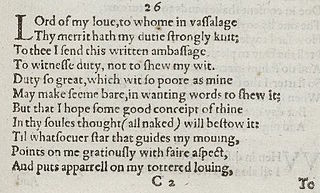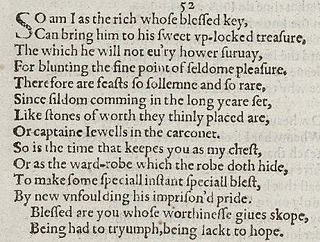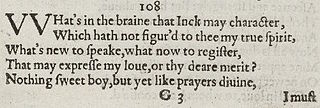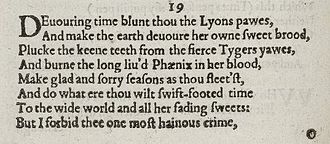
Sonnet 2 is one of 154 sonnets written by the English playwright and poet William Shakespeare. It is a procreation sonnet within the Fair Youth sequence.

Sonnet 22 is one of 154 sonnets written by the English playwright and poet William Shakespeare, and is a part of the Fair Youth sequence.

Sonnet 26 is one of 154 sonnets written by the English playwright and poet William Shakespeare, and is a part of the Fair Youth sequence.

Sonnet 27 is one of 154 sonnets published by William Shakespeare in a quarto titled Shakespeare's Sonnets in 1609. It is a part of the Fair Youth group of sonnets, and the first in a group of five sonnets that portray the poet in solitude and meditating from a distance on the young man. A theme of the first two of the group regards the night and restlessness, which is a motif also found in the sonnets of Petrarch.

Sonnet 48 is one of 154 sonnets written by the English playwright and poet William Shakespeare. It is a member of the Fair Youth sequence, in which the poet expresses his love towards a young man.

Sonnet 49 is one of 154 sonnets written by the English playwright and poet William Shakespeare. It is a member of the Fair Youth sequence, in which the poet expresses his love towards a young man.

Sonnet 52 is one of 154 sonnets written by the English playwright and poet William Shakespeare. It is a member of the Fair Youth sequence, in which the poet expresses his love towards a young man.

Sonnet 61 is one of 154 sonnets written by the English playwright and poet William Shakespeare. It is a member of the Fair Youth sequence, in which the poet expresses his love towards a young man.

Sonnet 62 is one of 154 sonnets written by the English playwright and poet William Shakespeare. It is a member of the Fair Youth sequence, addressed to the young man with whom Shakespeare shares an intimate but tormented connection. This sonnet brings together a number of themes that run through the cycle: the speaker's awareness of social and other differences between him and the beloved; the power and limitations of poetic art; and the puzzling sense in which love erases the boundaries between individuals.

Sonnet 63 is one of 154 sonnets published in 1609 by the English playwright and poet William Shakespeare. It is one of the Fair Youth sequence. Contrary to most of the other poems in the Fair Youth sequence, in Sonnets 63 to 68 there is no explicit addressee, and the second person pronoun is not used anywhere in sonnets 63 to 68.

Sonnet 91 is one of 154 sonnets written by the English playwright and poet William Shakespeare. It's a member of the Fair Youth sequence, in which the poet expresses his love towards a young man.

Sonnet 74 is one of 154 sonnets published by the English playwright and poet William Shakespeare in 1609. It is one of the Fair Youth sequence.

Sonnet 143 is one of 154 sonnets written by the English playwright and poet William Shakespeare.

Sonnet 90 is one of 154 sonnets written by the English playwright and poet William Shakespeare. It is a member of the Fair Youth sequence, in which the poet expresses his love towards a young man.

Sonnet 95 is one of 154 sonnets written by the English playwright and poet William Shakespeare. It is a member of the Fair Youth sequence, in which the poet expresses his love towards a young man.

Sonnet 106 is one of 154 sonnets written by the English playwright and poet William Shakespeare. It is a member of the Fair Youth sequence, in which the poet expresses his love towards a young man.

Sonnet 108 is one of 154 sonnets written by the English playwright and poet William Shakespeare. It is a member of the Fair Youth sequence, in which the poet expresses his love towards a young man.
Sonnet 120 is one of 154 sonnets written by the English playwright and poet William Shakespeare. It's a member of the Fair Youth sequence, in which the poet expresses his love towards a young man.

Sonnet 121 is one of 154 sonnets written by the English playwright and poet William Shakespeare. It is a member of the Fair Youth sequence, in which the poet expresses his love towards his young lover.

Sonnet 122 is one of 154 sonnets written by the English playwright and poet William Shakespeare, and first published in 1609. It is a member of the Fair Youth sequence, in which the poet expresses his love towards a young man. Although the relationship started exuberantly in Sonnet 18 by now it has given way to an almost defensive tone. The poet justifies giving away or losing a notebook ("tables") given him by the youth to record shared events by saying that his memories of them are stronger.





















